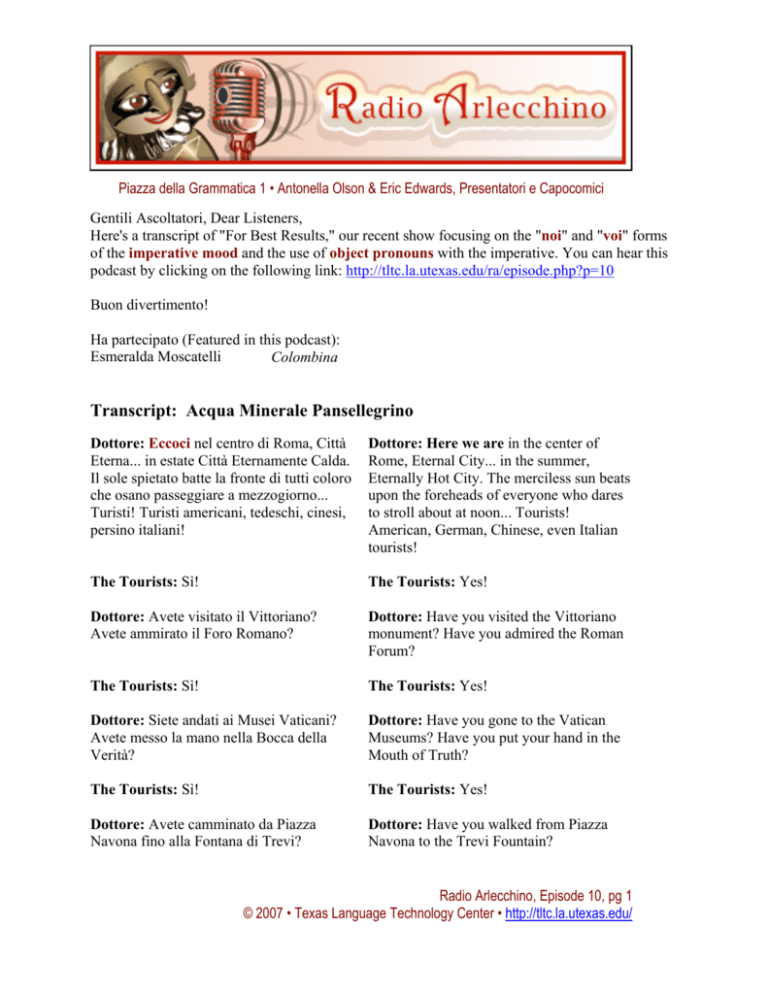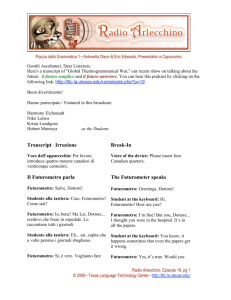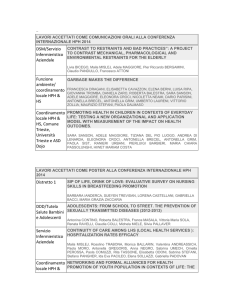PDF Transcript
advertisement

Piazza della Grammatica 1 • Antonella Olson & Eric Edwards, Presentatori e Capocomici Gentili Ascoltatori, Dear Listeners, Here's a transcript of "For Best Results," our recent show focusing on the "noi" and "voi" forms of the imperative mood and the use of object pronouns with the imperative. You can hear this podcast by clicking on the following link: http://tltc.la.utexas.edu/ra/episode.php?p=10 Buon divertimento! Ha partecipato (Featured in this podcast): Esmeralda Moscatelli Colombina Transcript: Acqua Minerale Pansellegrino Dottore: Eccoci nel centro di Roma, Città Eterna... in estate Città Eternamente Calda. Il sole spietato batte la fronte di tutti coloro che osano passeggiare a mezzogiorno... Turisti! Turisti americani, tedeschi, cinesi, persino italiani! Dottore: Here we are in the center of Rome, Eternal City... in the summer, Eternally Hot City. The merciless sun beats upon the foreheads of everyone who dares to stroll about at noon... Tourists! American, German, Chinese, even Italian tourists! The Tourists: Sì! The Tourists: Yes! Dottore: Avete visitato il Vittoriano? Avete ammirato il Foro Romano? Dottore: Have you visited the Vittoriano monument? Have you admired the Roman Forum? The Tourists: Sì! The Tourists: Yes! Dottore: Siete andati ai Musei Vaticani? Avete messo la mano nella Bocca della Verità? Dottore: Have you gone to the Vatican Museums? Have you put your hand in the Mouth of Truth? The Tourists: Sì! The Tourists: Yes! Dottore: Avete camminato da Piazza Navona fino alla Fontana di Trevi? Dottore: Have you walked from Piazza Navona to the Trevi Fountain? Radio Arlecchino, Episode 10, pg 1 © 2007 • Texas Language Technology Center • http://tltc.la.utexas.edu/ The Tourists: Sì! The Tourists: Yes! Dottore: Avete salito la scalinata in Piazza di Spagna? Dottore: Have you climbed the Spanish Steps? The Tourists: Oh, sì! The Tourists: Oh, yes! Dottore: Siete stanchi? Dottore: Are you tired? The Tourists: Sì! The Tourists: Yes! Colombina: Riposiamoci! Colombina: Let's rest! Dottore: Sentite il caldo dell’estate romana? Dottore: Do you feel the heat of the Roman summer? The Tourists: Sì! The Tourists: Yes! Colombina: Rinfreschiamoci! Colombina: Let us refresh ourselves! Dottore: Avete sete? Dottore: Are you thirsty? The Tourists: Sì! The Tourists: Yes! Colombina: Beviamo! Colombina: Let's drink! Dottore: Bravi! Bevete, sì! Venite, venite... Dottore: Fine! Drink, yes! Come, Come... Colombina: Andiamo! Colombina: Let's go! The Tourists: Sì! The Tourists: Yes! Dottore: Assaggiate l’acqua Pansellegrino! L’acqua piu deliziosa, più rinfrescante, più dolce di tutte le acque minerali del Bel Paese! Dottore: Try Pansellegrino water! The most delicious, most refreshing, sweetest mineral water of the Bel Paese! Colombina: Assaggiamola! Colombina: Let's try it! The Tourists: Sì! The Tourists: Yes! Dottore: Pulcinella, aiutami ad aprire le bottiglie e a versare quest'acqua frizzante! Vedete! Sentite! Quanto è effervescente! Dottore: Pulcinella, help me open the bottles and pour this sparkling water! See! Hear! How effervescent it is! Sip it! Radio Arlecchino, Episode 10, pg 2 © 2007 • Texas Language Technology Center • http://tltc.la.utexas.edu/ Sorseggiatela! Colombina: Assaporiamola! Colombina: Let's savor it! The Tourists: Sì! The Tourists: Yes! Dottore: Senti, Pulcinella, è meglio non -Pulcinella, mi raccomando, non fare così con la bottiglia! Dottore: Listen, Pulcinella, it's better not to -- Pulcinella, I beg you, don't do that with the bottle! The Tourists: Ah! The Tourists: Ah! Colombina: Proteggiamoci! Colombina: Let's protect ourselves! Dottore: Pulcinella! Dottore: Pulcinella! Colombina: Andiamo via! Colombina: Let's get out of here! The Tourists: Sì! The Tourists: Yes! Dottore: Dobbiamo avvertire che i migliori Dottore: We must advise that the best risultati si ottengono quando non si agitano results are obtained when the bottles are le bottiglie prima di aprirle... not shaken before opening them... Colombina: Cerchiamo degli asciugamani! Colombina: Let's look for some towels! The Tourists: Sì! The Tourists: Yes! Dottore: Ricordate, amici... è il vostro amico il Dottor Balanzone che vi raccomanda Acqua Pansellgrino... gassata - e come! Dottore: Remember, friends... it's your friend Dottor Balanzone who recommends Acqua Pansellegrino to you... fizzy -- and how! Transcript: una telefonata dal Colosseo Transcript: a phone call from the Coliseum Antonella: Ciao, Eric! Antonella: Ciao, Eric! Eric: Antonella! Ciao, come stai? Eric: Antonella! Ciao, How are you? Antonella: Bene, bene... Va ora in onda Radio Arlecchino? Antonella: Fine, fine... Is Radio Arlecchino on the air? Radio Arlecchino, Episode 10, pg 3 © 2007 • Texas Language Technology Center • http://tltc.la.utexas.edu/ Eric: Va in onda, sì! E tu, dove ti trovi oggi? Eric: Oh yes, it's on the air! And you, where are you today? Antonella: Siamo qui all'Anfiteatro Flavio... Lo conosci? Antonella: We're here at the Flavian Amphitheatre. Do you know it? Eric: Ma chi non lo conosce, anche se solo dalle foto... Eric: Why who doesn't know it, even if only from photographs... Antonella: Ah-hah... e cioè...? Antonella: Ah-hah... and that is...? Eric: Il Colosseo, certo... Eric: The Coliseum, of course... Antonella: Bravo! Sì, eccoci tutti, io, gli studenti, la guida... Antonella: Bravo! Yes, here we are, all of us, me, the students, the guide... Eric: E hai chiacchierato con qualche Gatto-Imperatore? Eric: And have you chatted with some CatEmperors? Antonella: Non ancora, però, proprio adesso mi sta intrattenendo un Gladiatore! Antonella: Not yet; however, right now a gladiator is entertaining me! Eric: Solo uno? Eric: Just one? Antonella: A dire il vero ce ne sono tanti nei paraggi... Antonella: To tell the truth there are quite a few of them around here... Eric: Mi auguro che gli studenti ti facciano qualche foto... Eric: I hope the students are taking some pictures of you... Antonella: Questa è l’idea! Antonella: That's the idea! Eric: Dopo ne sceglieremo una da mettere insieme a quelle di Nanni e Johnny... Eric: Later we'll pick one of them to put with Nanni and Johnny's... Antonella: Perfetto! Senti, ora ti saluto, adesso andiamo al Palatino... Antonella: Perfect! Listen, I'm saying good-bye to you, we're going to the Palatine now... Eric: Va bene... salutami Biceps Gloriosus... e buona passeggiata... Eric: All right, say hello to Biceps Gloriosus for me... and have a nice stroll... Antonella: Grazie, a presto, Eric... Antonella: Thanks, see you soon, Eric... Eric: A presto e....? Eric: See you soon and....? Radio Arlecchino, Episode 10, pg 4 © 2007 • Texas Language Technology Center • http://tltc.la.utexas.edu/ Antonella: Arisentirci! Antonella: Arisentirci! Nota Grammaticale By now the "noi" and "voi" forms of the imperative should hold no mysteries for you: they're identical to the present indicative, and negative commands are made simply by placing a "non" in front of these imperative forms. (Remember that the pdf file for Episode 8 has complete tables of the imperative forms for the three conjugations of verbs.) You've also been seeing, ever since Episode 8 when we began our discussion of the imperative, object pronouns being used with this verb form. And by now you could probably summarize the general rules for the use of pronouns with the imperative all by yourself: Object pronouns are attached to the end of the imperative. The exception, once again, is the formal, or third-person, imperative, which is really the present subjunctive. Object pronouns always come in their usual place in front of verbs in the subjunctive, even when the subjunctive is being used as the formal imperative. Talk to me about the imperative! informal singular Parlami dell'imperativo! formal singular Mi parli dell'imperativo! informal plural Parlatemi dell'imperativo! formal plural Mi parlino dell'imperativo! When there are two object pronouns, both are attached to the end of the imperative and the indirect object pronoun will always be the first of the two. If the difference between direct- and indirect-object pronouns is problematic for you, pazienza! We take up the subject of pronouns in our next episode! There are two newspapers on the table. Bring them to me! Ci sono due giornali sul tavolo... informal singular Portameli! formal singular Me li porti! informal plural Portatemeli! formal plural Me li portino! A special word about pronouns with monosyllabic imperatives. You will remember that the second-person singular imperative of the verbs andare, dare, dire, fare, and stare is a onesyllable contracted form of the present indicative. When a pronoun is attached to one of these Radio Arlecchino, Episode 10, pg 5 © 2007 • Texas Language Technology Center • http://tltc.la.utexas.edu/ forms, you always use the contracted form (not the form that ends in –i) and you double the initial consonant of the prounoun. The exception is gli – you never double the initial –g. Andare: va! This verb doesn’t really take direct or indirect objects, but it is very often used with the particle ci (“to that place, there”), which behaves just like a pronoun in terms of its placement in relation to a verb. So: Go there! Vacci! and the others… da + mi = dammi ti = datti gli = dagli le = dalle ci = dacci fa + mi = fammi ti = fatti gli = fagli le = falle ci = facci Examples: Give us a hand! Dacci una mano! and so on... Don’t be a stranger! (“Make yourself alive”) Fatti vivo! Tell her everything! Dille tutto! Stay close to me! Stammi vicino! Pronoun placement with negative commands is flexible. When the imperative is negative, pronouns can go in front of the verb (and after the non) or be attached to the end of the imperative form -- EXCEPT with the formal imperative, of course. Object pronouns always come in their usual place in front of verbs in the subjunctive, even when the subjunctive is being used as the formal imperative--whether the command is affirmative or negative. The imperative? Don't talk to me about it any more! L'imperativo?... informal singular Non parlarmene più! Non me ne parlare più! formal singular Non me ne parli più! only possible configuration informal plural Non parlatemene più! Non me ne parlate più! formal plural Non me ne parlino più! only possible configuration Pronouns with the "noi" form of the imperative. This is relatively straightforward, as it follows the pattern seen in all the above examples and the informal/formal distinction is not an issue. Radio Arlecchino, Episode 10, pg 6 © 2007 • Texas Language Technology Center • http://tltc.la.utexas.edu/ Here's Colombina. Should we talk to her about the imperative? Ecco Colombina. Dobbiamo parlarle dell'imperativo? Affirmative: Let's talk to her about it! Parliamogliene! Negative: Let's not talk to her about it any more! Non parliamogliene più! Non gliene parliamo più! Again, if these forms of the pronouns are not entirely clear to you, please be sure to follow our discussion of pronouns beginning with our next episode! Behold the wonder of ecco! You probably have noticed the word "ecco" in our dialogues and commercials with pronouns attached to it. Even though this word is not, technically speaking, an imperative form of a verb, it behaves like one in terms of pronoun placement. This makes perfect sense if you think of "ecco" as meaning "behold!" (look here!), which it does. Of course it has no negative form and is informal as far as pronoun placement is concerned. --Where is Dottor Balanzone? --Dov'è il Dottor Balanzone? --Here he is! (Behold him!) --Eccolo! Nota Culturale Le bibite preferite degli italiani - Favorite beverages of the Italians If you visit Italy you may find a little overwhelming the number of different brands of Italian waters available. From the very trendy and lightly bubbled San Pellegrino (please, if you are about to order a bottle of it call it ‘San Pellegrino’ and not ‘Pellegrino’ as many Americans erroneously do) to the plain Acqua Panna, the love for waters in Italy goes hand in hand with the love for food. Although several multinational corporations, Nestlé for example, have bought up some of the most famous brand names, the springs are undoubtedly located in Italy so we still consider them a national treasure. Every region has its own favorite water and many of the springs have been well known since Roman times. In many Italian cities, though, the best water comes free. In Rome, for example, beyond the monumental fountains there are approximately 2500 fontanelle from which the water flows day and night. They are called nasoni, cylinders of metal (cast iron or iron) from which the water flows through an arched steel tube that, to the Romans, suggests a nose, hence the name. Radio Arlecchino, Episode 10, pg 7 © 2007 • Texas Language Technology Center • http://tltc.la.utexas.edu/ Water aside, a long tradition of non-alcoholic beverages is well established in Italy and every region has its own traditional and most famous beverages. The most famous drinks are chinotto (extracted from a citrus type of plant, it may be bitter tasting but it is worth trying. If you explore the web you will be surprised to find many chinotto fan clubs), gassosa (a mix of water-sugar– carbonation that has a quite large audience in Rome), oransoda (extracted from oranges and lightly sparkling), lemonsoda and limonata (extracted from lemons, with and without bubbles), latte di mandorle (a special milk extracted from almonds and diluted with water. It is especially famous in the southern part of Italy. Sicily is the largest producer of almonds in Italy.) Crodino is a bitter-sweet tasting non-alcoholic aperitif that you consume with salted nuts and chips, and there are succhi di frutta (fruit juices in all forms and shapes), and of course caffè (yes, it is considered a beverage for us!). Coca-Cola? No thanks! Monumenti romani ‘Ave Cesare, morituri te salutant’ (Hail, Caesar, those who are about to die salute you). The beginning of any gladiators’ fights was not encouraging since it was assumed that one of the two men engaged in the fight would die in the process or would be defeated and later killed. At the end of a fight, the loser would raise his arm to plead for mercy. This delicate decision was in the hands of the emperor or the presiding authority but normally they would let the spectators decide the fate of the gladiator. If the public liked the fight, they would yell ‘mitte’ (spare him) and they would accompany their voices with the upward movement of their thumb and their hand in a fist. But if they didn’t like the performance they would shout ‘iugula’(cut his throat) and the thumb was turned down (pollice verso). Despite all the legends surrounding the gladiators, it is worth remembering that many specialists in the field, historians and archeologists, do not agree on the level of violence, and especially death, linked to gladiatorial combat. Many claim that training a gladiator was such an expensive and long process that it would not be justified by such a sudden and fast death. But as Hollywood’s children, learning from Kirk Douglas as Spartaco to Russell Crowe as Maximus, we truly believe in what we see on the screen. Don’t we all? The gladiators and Roman legionaries who hang out at the Coliseum today are neither specters nor feline incarnations; they are friendly, contemporary citizens whose historical costumes invite visitors, as the Dottore might say, to Carpe occasionem photographae! – “Seize the photo op!” Most of the Roman monuments mentioned in this episode are familiar to just about everyone. Not quite as well known is la Bocca della Verità, the Mouth of Truth., a marble disk adorned by the face of a river god that hangs in the portico of the church of Santa Maria in Cosmedin. Generally believed to be an ancient Roman drain cover, its legendary power is that of detecting the presence of liar when such a person inserts his or her hand into its mouth. This detection is Radio Arlecchino, Episode 10, pg 8 © 2007 • Texas Language Technology Center • http://tltc.la.utexas.edu/ supposedly manifested by the mouth’s biting off the liar’s hand. A no-longer-new but very entertaining Hollywood film in which the Bocca della Verità is featured prominently in a delightful scene is Roman Holiday starring Gregory Peck and Audrey Hepburn. Thanks for listening! And be sure to tell your friends that you heard it here on Radio Arlecchino! Your hosts with the most – grammar, Antonella Olson & Eric Edwards “Out of our minds ... into your ears” Radio Arlecchino, Episode 10, pg 9 © 2007 • Texas Language Technology Center • http://tltc.la.utexas.edu/

